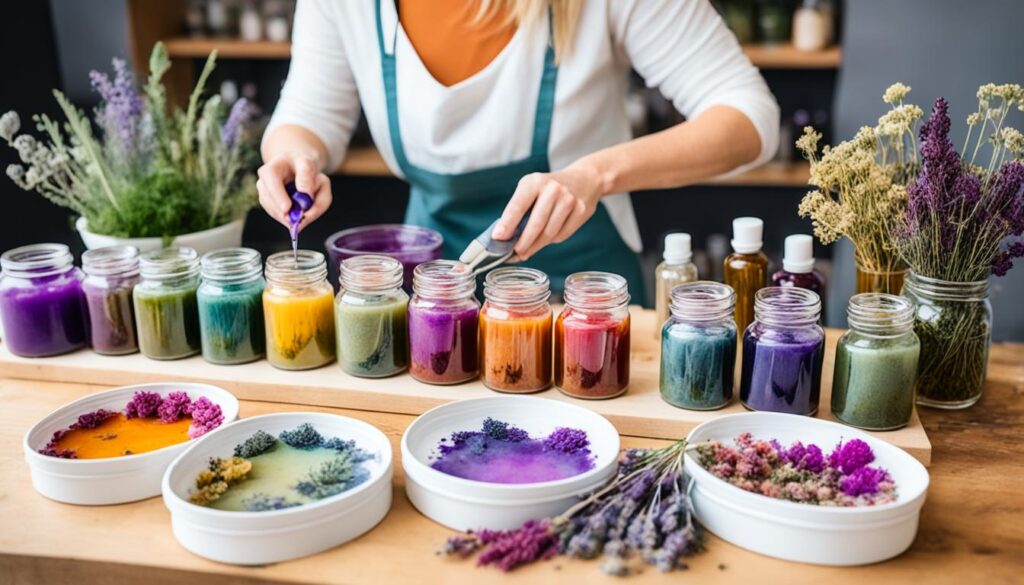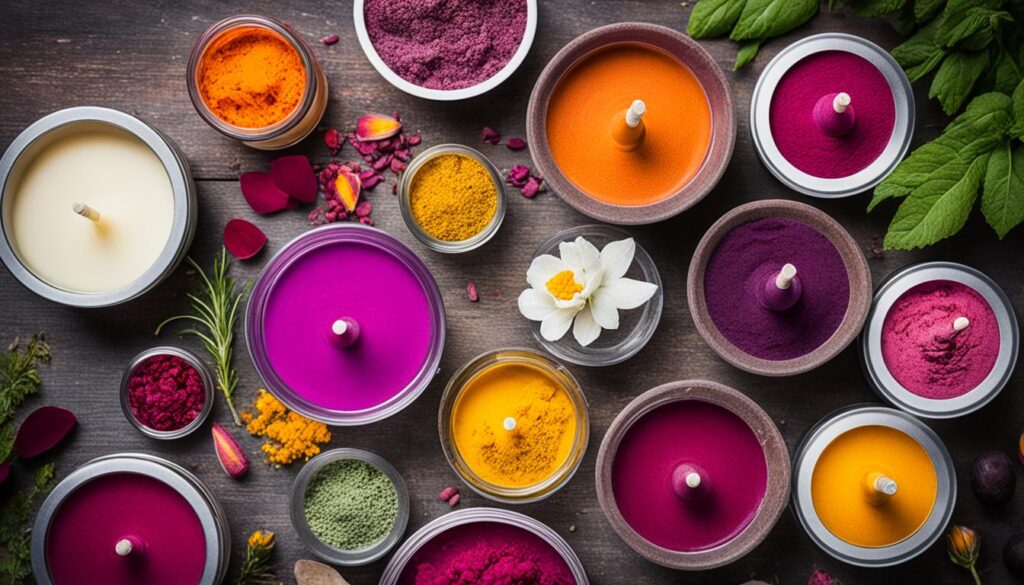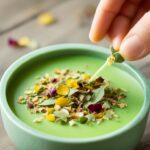How to Color Your Candles Naturally
Imagine making your home look amazing with candles that are naturally colored. These candles not only look great but also support your eco-friendly lifestyle. But, you might ask, Can I get bright, lasting colors for my candles with natural dyes? Yes, you can! We’ll show you how to use natural pigments to make your candles stand out.
Key Takeaways
- Discover the benefits of using natural colorants for your candles
- Explore a variety of plant-based dyes and pigments that can be used for candle-making
- Learn the step-by-step infusion method to create beautifully-colored soy, beeswax, and palm wax candles
- Uncover tips and tricks for achieving your desired shades and preventing common issues like fading
- Embrace the versatility of natural candle coloring and explore unique color options
Introduction to Natural Candle Coloring
In the world of eco-friendly candle making, natural wax candles are a top choice. They are made without artificial ingredients or synthetic dyes. This lets you explore the beauty of natural colors. By using natural colors, you can make stunning, safe candles that improve your home and help the planet.
What are Natural Candles?
Natural candles come from renewable sources like soy, palm, or beeswax. They don’t have harsh chemicals or synthetic additives. Plant-based dyes are used instead of artificial ones, making the process safer and greener.
Benefits of Using Natural Colorants
- Reduced environmental impact: Natural dyes come from plants, making your candle-making process greener.
- Safer ingredients: These dyes don’t release harmful toxins when burned, making your home safer.
- Unique, earthy tones: You can find a wide range of natural colors that synthetic dyes can’t match, adding beauty to your candles.
Using natural candle coloring can make your candle-making more special and eco-friendly. Discover the beauty and benefits of natural wax candles and let your creativity flow.
“Natural candles are not just a beautiful addition to your home, but a conscious choice to support a greener, more sustainable future.”
Understanding Natural Dyes
Coloring your candles naturally opens up a world of plant-based options. These eco-friendly dyes can change your candles’ look. They offer many natural colors to match your style and support sustainability.
Types of Natural Dyes for Candles
Popular natural dyes for candles include:
- Madder root: Imparts shades of red and pink
- Alkanet root: Produces deep burgundy and purple hues
- Annatto seeds: Lend a warm, golden-yellow color
- Peppermint: Infuses a vibrant, minty green tone
- Spirulina: Creates a stunning, vibrant blue-green shade
Lesser-known options like comfrey, rose hips, and lavender also exist. They add subtle, earthy colors to candles.
“Incorporating the beauty of nature into your candles is a truly rewarding experience. The endless possibilities of natural wax color options allow you to express your creativity and embrace a more sustainable approach to candle making.”
| Natural Dye | Color Range | Unique Properties |
|---|---|---|
| Madder Root | Red, Pink | Vibrant, long-lasting hues |
| Alkanet Root | Burgundy, Purple | Rich, earthy tones |
| Annatto Seeds | Golden Yellow | Warm, sunny shades |
| Peppermint | Vibrant Green | Refreshing, minty hues |
| Spirulina | Blue-Green | Striking, bold color |
Preparing Your Workspace
Setting up a dedicated workspace is the first step in your natural candle coloring journey. Gather the necessary supplies and create an organized environment. This ensures a smooth and enjoyable candle-making experience.
To start, you’ll need to set up a candle making station with a few essential items. A double boiler or slow cooker is crucial for melting the wax. You’ll want to maintain a consistent temperature throughout the process. Jelly jars or other containers will serve as your infusion vessels, where you’ll combine the wax with your natural colorants.
- Gather supplies for natural candles, such as coffee filters or cheesecloth, to contain the plant material during the infusion process.
- Collect your basic candle-making tools, including wicks, twist ties, and any molds or containers you plan to use for the final candles.
With these essential supplies for your workspace in place, you can now focus on creating an organized workspace. This will help you have a stress-free and efficient candle-making experience. Make sure your work area is clean, well-lit, and free from potential distractions or clutter.
“The secret of getting ahead is getting started.” – Mark Twain
By taking the time to set up your candle-making station properly, you’re setting the foundation for a successful and enjoyable natural candle coloring process. With your workspace ready, you can now move on to the next step of infusing your wax with natural dyes.
The Infusion Method
Exploring natural candle coloring techniques is rewarding and eco-friendly. It lets you add unique hues to your homemade candles. The infusion method is great for using plant-based dyes. It involves suspending colorants in melted wax, letting the pigments infuse fully over time.
Supplies Needed
- Soy container wax
- Herbs, spices, or other natural dye sources of your choice
- Coffee filters or cheesecloth
- Twist ties
Step-by-Step Instructions
- Prepare your jars or containers by filling them with the soy wax.
- Place your chosen natural colorants, like ground turmeric, dried lavender, or ground beets, into a coffee filter or cheesecloth sachet.
- Secure the sachet with a twist tie and carefully submerge it in the melted wax.
- Allow the wax and natural dye infusion to steep for 24-48 hours, keeping the temperature low and consistent.
- Once the desired color intensity is reached, remove the sachet and discard it.
- Pour the infused wax into your candle molds or jars and let them cool and harden.

The infusion method is a gentle way to add plant-based dyes to your candles. It lets you get vibrant and earthy tones without adding too much plant material. This makes your candles look beautiful and natural.
natural candle coloring
Making natural color candles is a fun and green way to brighten your home. You can use plant-based candle dyes to get unique, natural colors without synthetic stuff. This eco-friendly candle making takes time, but it’s worth it for candles that look great and are good for the planet.
To get vibrant, natural color candles, you need to infuse the wax with things like herbs and spices. This lets you create a variety of colors that fit any room. You can pick from calming lavender, cozy cinnamon, or bright beets, among others.
First, gather your stuff and set up your space. Once you know how to infuse, try different methods and mix colors for the look you want. With creativity and patience, you’ll make natural color candles that are not just pretty but also show you care about the earth.
| Natural Dyes for Candles | Color Achieved |
|---|---|
| Turmeric | Golden Yellow |
| Beet Powder | Vibrant Red |
| Spirulina Powder | Deep Green |
| Dried Hibiscus Flowers | Fuchsia |
| Activated Charcoal | Slate Gray |
Let nature’s beauty inspire you as you play with natural color candles. With some trial and a love for the earth, you can make candles that look amazing and match your green lifestyle.
Alternative Infusion Methods
There are other ways to make candles besides the traditional slow cooker method. You can try alternative natural candle coloring techniques and DIY candle making methods with different appliances and techniques. This can help you find the best way to make candles.
Using Different Cooking Devices
You can use a Presto Pot, Instant Pot, or a crockpot on low to infuse wax with color. These devices create a steady, low heat. This lets you infuse wax with natural colorants just like the traditional method.
No-Jar Method
The no-jar method is another way to infuse wax. Melt the wax in a pot and add plant material. Once it’s infused, pour the wax into molds or containers. This is handy if you don’t have a slow cooker and jelly jars.
Trying these different methods can expand your options for natural candle coloring. It helps you find the best method for your needs and likes.

Achieving Desired Shades
Using natural dyes for candle-making lets you try out many unique colors. You can make lighter or deeper colors by changing how much plant material you use. Mixing different natural colorants, like madder root, alkanet, and spirulina, lets you create custom color palettes.
Adjusting Dye Amounts
You can change your candle’s color by playing with plant-based dyes. Start with a little dye and add more until you get the shade you want. This way, you can make soft or bold colors, keeping your candles natural.
Blending Colors
Blending different natural colorants lets you experiment with color intensity and make unique customized natural candle colors. You can mix various plant-based dyes to get a wide range of hues, from earthy to bright. Be creative and try different mixes to find your favorite colors.
“With a little practice and careful observation, you can develop your own signature natural candle color schemes.”
Candle-making with natural dyes is a fun journey of discovery and creativity. By learning how to adjust dye amounts and mix colors, you can make endless unique customized natural candle colors and experiment with color intensity. Let your imagination run wild.
Troubleshooting and Tips
Natural candle coloring is very appealing, but you might face some challenges. Knowing these issues and how to fix them can help. This way, your candles will stay colorful and bright for a longer time.
Preventing Sediment in Wax
Sometimes, natural candle coloring can lead to sediment in the wax. This happens because the dyes used are plant-based. To avoid this, let the wax settle well before making your candles. This lets any bits settle at the bottom, making your candles look smoother.
Combating Fading Issues
Natural colors can fade over time, especially when they’re exposed to sunlight or other environmental factors. To keep your candles looking great, store them in a cool, dark place away from direct light. This helps keep the colors vibrant.
Also, think about using natural fixatives like beeswax or soy wax. These can help keep the color in and stop it from fading too quickly. With the right care, your homemade candles will stay beautiful for a long time.
| Challenge | Solution |
|---|---|
| Sediment in Wax | Let the infused wax settle thoroughly before pouring |
| Color Fading | Store candles in a cool, dark place and use natural fixatives |
By tackling these common natural candle coloring challenges, you can prevent sediment in wax and extend the lifespan of your natural candles. This ensures they keep looking great for years.
Exploring Natural Color Options
Starting your journey to make candles with natural colors opens up many options. You can go beyond traditional dyes like madder root and alkanet. Use tea bags and other plants to find new colors for your candles.
Tea Bags for Coloring
Tea is a great choice for coloring candles naturally. Steep tea bags in melted wax to get colors from creamy yellows to deep reds. Different teas have unique colors to try.
Other Unique Natural Sources
There are many other plants that can color your candles. Spices like turmeric, annatto, and paprika make golden candles. Dried flowers add pink and orange colors. Vegetable extracts, like beet or carrot juice, give reddish-brown shades.
Using these natural dyes makes each candle special. It’s a fun way to be creative and surprise people with unique colors.
“Exploring the endless possibilities of natural candle coloration is a journey of discovery, where each batch becomes a unique work of art.”
Enhancing Your Candles
There are many ways to make your candles more special. You can try different techniques and add special elements. This makes your eco-friendly candles unique and eye-catching.
The cold pour technique is a great way to add texture and patterns. You pour the melted wax into a mold when it’s a bit cooler. This lets the wax cool slowly, creating a unique look.
Adding soy wax or vegetable shortening can also improve your candles. It makes the wax feel creamier and more luxurious. This makes your eco-friendly candles look even better.
Try using different mold shapes and wick placements. You can also add things like dried flowers or herbs. These small changes can make your candles really stand out.
“Enhancing your naturally-colored candles is all about adding personal touches and embracing the unique character of each piece.”
Pay attention to the details to make your eco-friendly candles special. This way, you create a product that shows off your style and love for the planet.
Conclusion
Coloring your candles with plant-based dyes is a fun and green way to make them stand out. You can learn about different natural colors and how to use them. This lets you make candles that are truly unique and good for the planet.
By using plant-based dyes, you make beautiful candles and help the environment. These dyes are good for the earth because they break down easily, aren’t harmful, and can be made again. Making candles this way feels rewarding and lets you show off your creativity.
Now you know how to make natural candles and can start your own project. Try out different natural colors and see your candles come alive with nature’s beauty. Start this journey and make candles that show you care about the planet.
FAQ
What are natural candles?
What are the benefits of using natural colorants in candle-making?
What types of natural dyes can be used to color candles?
What supplies do I need to start coloring my candles naturally?
How do I use the infusion method to color my candles naturally?
Are there any alternative approaches to the traditional infusion method?
How can I experiment with different natural color combinations?
What are some potential challenges with using natural dyes for candle-making?
What other natural materials can be used to color candles?
How can I further enhance my naturally-colored candles?
Source Links
- https://www.thesprucecrafts.com/infuse-natural-colors-in-candles-517204 – Learn How to Infuse Natural Colors Into Your Soy Candles
- https://www.naturesgardencandles.com/candle-making-supplies/shop/candle-coloring/ – Colorant for Candles | Concentrated, Natural Dyes & Candle Coloring
- https://www.howtomakecandles.info/techniques/2106/how_to_color_a_candle_with_tea_bags – How to color a candle with tea bags? • HowtomakeCandles.info
- Fragrance That Wows: A Beginner’s Guide to Adding Scents to Your Homemade Candles
- best essential oils for candles
- wood wick guide
- how to make candles smell stronger
- how to ship candles
- how to fix soy wax frosting
- wick Guide how to choose the right wick size with chart
- how to make candle molds
- how to clean candle wax
- how to reuse candle jars
- soy wax candle troubleshooting
- best wax melter for candle making
- how to conduct burn test
- why candle flickering crackling smoking
- how much wax per candle
- how to make candles smell stronger
- Easy Ways to Increase the Scent Throw of Your DIY Candles
- How to Make Candles for Meditation and Relaxation
- Using Upcycled Materials in Candle Making
- How to Make Hand-Poured Candles: Tips and Techniques

Leave a Reply